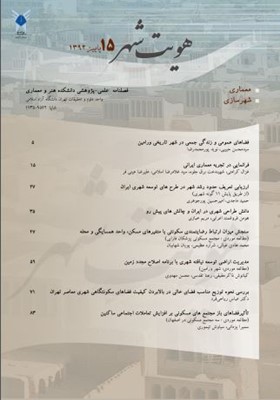تاثیر فضاهای باز مجتمع های مسکونی بر افزایش تعاملات اجتماعی ساکنین ، (مطالعه موردی : سه مجتمع مسکونی در اصفهان)
محورهای موضوعی : معماریسمیرا یزدانی 1 , سیاوش تیموری 2
1 - کارشناسی ارشد معماری، دانشگاه آزاد اسلامی واحد خوراسگان (اصفهان). اصفهان. ایران
2 - دکترای معماری ، دانشگاه آزاد اسلامی واحد علوم و تحقیقات. تهران. ایران
کلید واژه: مجتمع مسکونی, فضاهای باز, تعاملات اجتماعی, روابط همسایگی,
چکیده مقاله :
به دلیل رشد شهرنشینی دهه های اخیر در ایران، الگوی تولید مسکن تغییر یافته و لزوم ایجاد انبوه مسکن، سبب کاهش کیفیت و مطلوبیت طراحی ها گشته است. طراحی مجتمع های مسکونی امروزی به دلیل عدم توجه به نیازهای انسانی و در نظر نگرفتن پیامدهای روانشناختی آن، زندگی فردی و اجتماعی ساکنین را با مشکلاتی مواجه ساخته است. از جمله نیازهای فراموش شده انسان ها در این طراحی ها، تعاملات اجتماعی است. تحقیق حاضر از نوع کاربردی پیمایشی است، پس از تبیین ابعاد مختلف اهمیت روابط اجتماعی میان انسان ها، به بررسی نقش فضای باز در افزایش تعاملات اجتماعی ساکنین مجتمع های مسکونی پرداخته و نظرات ساکنین سه مجتمع مسکونی در اصفهان بررسی گردیده است. یافته ها نشان می دهد عواملی چون همگنی اجتماعی ساکنین و به کارگیری الگوهای طراحی جهت ایجاد شرایط امن،جذاب و راحت برای حضور خانواده ها در فضاهای باز مجتمع، تأثیر به سزایی در افزایش تعاملات اجتماعی همسایگان دارد.
Iranian patterns of construction have changed severely in the last decades, due to the increasing urbanization processes, as in many other countries worldwide, Demands for large scale building constructions decreased the sensitivity and accuracy of the Architectural designs. Lack of appropriate concern and consideration for human needs and the subsequent psychological effects on modern residential designs in Iran causes many complications in social and individual life. Among the most important human needs, which have been neglected in the modern Iranian designs, we can mention the needs for privacy and social interactions. Today, based on a wide verity of reasons people are required to live a collective life in the form of “multi-unit building”. However they are not only deprived from the advantages of this kind of social life, but also they consider this situation, as a compromise to their privacy and individuality. This also contributes to the problems of relationship between the residents. In fact, there should be a solution to establish a balance between the social interaction and privacy of people living in such a situation. On the other hand, in Iran, being neighbors is traditionally considered as a close functional and emotional relationship. Therefore, the roots of the current cold relationships in residential environments should be looked for in the lack of consideration in the design of the neighborhoods and buildings. Also, In the contemporary architecture of Iran, following the decline of open spaces in residential architecture, and converting them to a route for moving cars, not only these spaces are not adequate to satisfy social needs but cause the cutting of social relations in the neighborhoods. So, considering the importance of relationships and social interactions between humans and ignoring that in modern designs, as for the lacking of such researching in the country, this study will improve the social interactions of residents and enhance neighborly relations by examining and understanding the factors in the design of open spaces in residential complexes. This study is the type of applied-survey research, after explaining the various aspects of social relationships among humans, investigates the effect of environment and the role of open spaces in increasing the social interactions of residents. And in the process of this review has been used the comments from residents of three residential complexes in Isfahan for quantitative assessment. These residential complexes have different patterns of design; “Zeitoon complex” is an example that has been attended to the type of landscaping design and creation of open spaces. “Moshtagh complex” is another complex that has a wide outdoor space but considering the various factors in the design of open space can be seen less. “Aftab complex” is the third complex that has no open space. After analyzing the questionnaires responses, findings show that various factors such as socially homogeneous of residents and use of effective design patterns for creating the safe, attractive and convenient environment for the presence of family members in open spaces of complex has considerable impacts in relationships and social interactions of the neighborhoods.
7 . عزیزی، محمدمهدی ؛و ملک محمدنژاد، صارم. (1386). بررسی تطبیقی دو الگوی مجتمع های مسکونی(متعارف و بلندمرتبه) مطالعه موردی: مجتمع های مسکونی نور و اسکان تهران. مجله هنرهای زیبا. )32 (، 27-38.
22. Scotthanson, C., & Scotthanson, K. (2005). The Cohousing Handbook: A Place for Community.(1st ed.). Canada: New Society Publishers.
24.Google earth V6.2.2.6613 .(July 18, 2013).Razmandegan st, Isfahan.39°42’ 03.83”N,51°39’ 10.81”E, Eye alt 6322 ft. DigitalGlobe 2013.http://www.earth.google.com [December 8, 2013].
25.Google earth V6.2.2.6613 .(July 18, 2013).Sepahanshahr, Isfahan.32°33’ 07.13”N,51°41’ 06.09”E, Eye alt 5697 ft. DigitalGlobe 2013.http://www.earth.google.com [December 8, 2013].
26.Google earth V6.2.2.6613 .(July 18, 2013).Sarvesaran st, Isfahan.32°37’ 45.66”N,51°43’ 55.89”E, Eye alt 6374 ft.DigitalGlobe 2013.http://www.earth.google.com [December 8, 2013].
_||_

